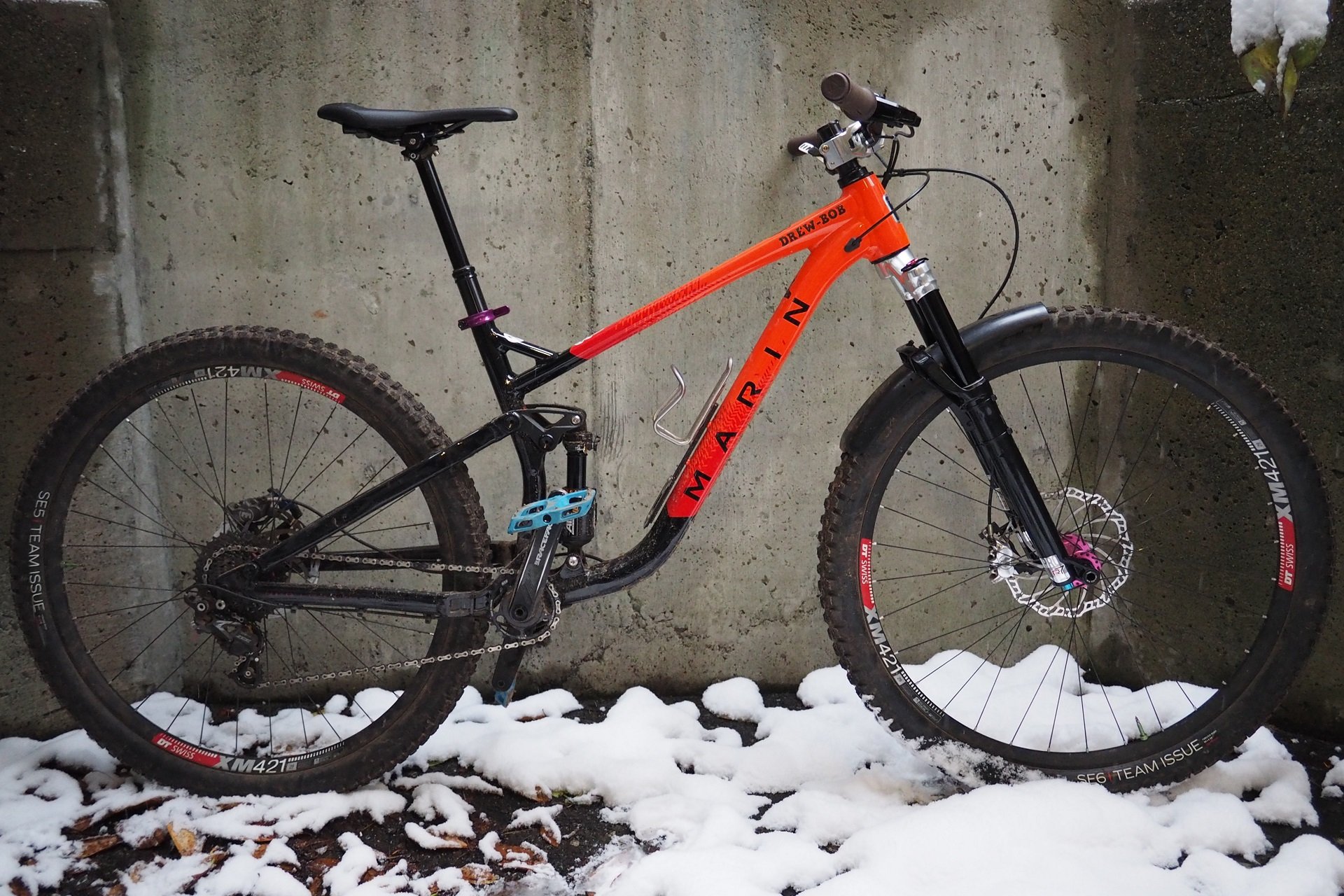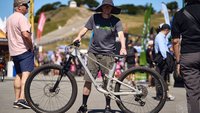
REVIEW
Marin Oso Composite Flat Pedals
Oso osO
Marin Bikes has been quietly filling out a component line that features budget-friendlier parts, including these nylon-composite Oso flat pedals. The 110 mm wide x 120 long x 18 tall dimensions qualifies them for the medium-large category. The body has an ever-so-slightly shaped body that Marin calls concave and I call neutral. They sell for 55 USD | 65 CAD, which is a rare example of us Canuck's winning on the exchange rate, likely thanks to Marin Canada's order timing. They come in two colours, the blue units I'm riding or black, both with grey graphics.
I hope Marin will add another size 2023 with a platform in the 75mm wide x 95mm long range that would be perfect for groms. Build in some bias for the fact I bought one, but I do think Marin's San Quentin 24" (SQ24") sports the best kids' hardtail geometry, in one of the best value builds on the market. In the same vein as I'd love to see Chromag add a 24" kids' hardtail, that would pair with their market-leading Radar kids' pedal, I think I'm justified in thinking Marin could do well selling a kids' Oso pedal that pairs well with the SQ20" and SQ24".

Oso uses a standard flat pedal configuration with an 8mm nut holding a steel axle that spins on an inboard bushing and outboard cartridge bearing.

The guts are easily replaceable, though in my experience with other composite pedals, the bodies are usually cooked around the time fresh internals are desired.
The pedals I've been riding most back-to-back with the Oso have been Wolf Tooth's Waveform in a size large. They're a similar neutral shape and the Wolf Tooth has a 112mm wide by 116mm long platform that feels the same size underfoot. The Waveform is a significantly more expensive, in-house, USA-made, flat pedal that's hopefully a very long-term investment at 200 USD | 280 CAD for a pair. To really bang that home, a single Minnesota-made Waveform pedal body will cost more than a pair of Oso pedals. The Wolf Tooth has a greater mechanical grip in my first-choice footwear, the Crankbrothers Stamp, especially on my hardtail, but the Oso is no slouch. I had no issue swapping the Marin pedals with other regular favourites including the NSBillet Daemon, OneUp Composite, and Kona Wah Wah 2 during testing.
The Oso pedal body is 18 mm thick, compared to the Waveform's 14mm leading edge, and it's taller than any of the other pedals I'm riding. The race for the thinnest has always been a bit like the race for the lightest bike of any travel category. It's a talking point, but whether you're riding these 18mm tall Oso pedals or the 6mm leading edge on some Canfield Crampons matters about as much as the difference between a 29.99lb and 34lb Enduro bike when you're actually out on the trail. I didn't notice any more trail contact with my pedals running the Oso versus my Wah Wah 2s and the bottom bracket height on my full suspension rig is low.

With my -2° angleset and 175mm cranks the bottom bracket height on my full suspension bike is towards the low side for a 120mm rig.

The 55 USD | 65 CAD Oso pedals have taken a proper beating and look like any other composite pedals would at this point.
The Marin pedals are a very flat, neutral shape, and they work well for me with my more mid-foot pedaling position. They'd be an excellent choice for any rider who's still working out where they like their feet, or those riders I've talked to who have adapted their flat pedal riding to climb more on the ball of their foot and descend in a more arch-over position. I'm sticking to one position, but I know an increasing number of flat pedal riders experimenting with a fore-aft range who are loving the results. While they're advertised as being concave, the amount of concavity probably won't speak to the true ball-of-foot flat pedal rider to the same extent as the classic Chromag Scarab or DMR Vault.
The Oso could be the perfect pedal if Marin can build a pair into the retail price of all their 'real' mountain bikes. Or even increase their bike prices just enough to roll in some proper pedals. Or even have a coordinated dealer program where purchasers of Marin bikes can pick up a pair for a screaming deal. I could say the same thing about other companies, like Trek or Kona, that have good or great composite flat pedals with metal pins. In the meantime, they have another good choice with a shape and size that will work for most riders in the market for a composite flat pedal at a fair price.
For more information on the 55 USD | 65 CAD Oso Flat pedals check out your local Marin dealer or Marin's webstore where available.











Comments
kcy4130
1 year, 3 months ago
Trail clearance isn't the only advantage of thin pedals. The thinner it is the closer ones shoe is to the axle and thus more force can be applied parallel to the pedal body before the pedal will roll under ones foot. Applying more force is good for climbing pushing pedal forward as it goes past 12 o clock and back as it goes past 6. When you have feet flat (i.e. heels not dropped) and unexpectedly hit something that slows or stops you, is the other time when the pedal can roll underfoot. Sometimes the pedal end up under your heel, sometimes it'll rake up the back of your calf. This seemed to happen a lot to me back when pedals were extra thick and shoes were not so grippy. Longer platforms also help reduce the roll.
Reply
Andrew Major
1 year, 3 months ago
I can’t argue the physics, but I do lots of technical out of the saddle climbs on my Rifty (I ride it like a hardtail) and I didn’t notice a difference between the extra thickness and thinner pedals, including much thinner pedals, I’ve ridden that wasn’t cosmetic.
Perhaps it’s a case of diminishing returns after a certain thinness has been reached (I wouldn’t call these “extra thick”). Perhaps larger pedal bodies, as you note. I don’t ride particularly super-sticky shoes.
Reply
kcy4130
1 year, 3 months ago
No, these aren't overly thick. I meant the really thick ones that were the norm 15 years ago. I definitely noticed a big improvement going from a ~22mm thick to 16mm a decade or so ago.
There was at least one company that put the bearings in the crank arm so the platform could be minimized. With bearing and axle in crank arm pedals could be made with the axle above the platform, like drop pedals. This would make for a very stable connection, a force applied parallel to the platform would want to rotate the pedal to be normal to force. Obviously only one side of the pedal would be used, and frame bb height would have to be correspondingly higher to compensate. I don't know how it'd feel to ride, but it would be a fun experiment.
Reply
Andrew Major
1 year, 3 months ago
Flypaper Pedals!
I wonder if there is anyone out there still riding them? Good chance seeing as you had to replace the cranks to change.
Reply
Vik Banerjee
1 year, 3 months ago
I ran into the inventor of the Flypaper pedals in Sedona a long time ago and got to try a set. The ride feel was great, but I was over beta testing stuff and just stuck with the thinner "normal" pedals I could get a hold of at the time.
Reply
Andrew Major
1 year, 3 months ago
Pedals like the Wah Wah 2 and OneUp aluminum that house a large bearing inboard of the body and are quite thin - but still use a traditional axle - are a natural evolution. Thin enough but without a proprietary crank.
I do and don’t miss the mad science of past product development.
JT
1 year, 3 months ago
Let us not forget the beauty that was/wasn't the Tioga MT Zero:
Reply
Andrew Major
1 year, 3 months ago
Tioga should get an award for the most forgettable actually interesting mountain bicycle products.
I was talking to someone* the other day about their oversized DH286 1-1/8" handlebar/stem combination and they were so incredulous that I had to stop and check that I hadn't dreamed the whole thing up.
*And in my defense, it was a fellow bike nerd who's been around longer than I have.
Andy Eunson
1 year, 3 months ago
Shimano made the Dyna Drive system for road bikes back in the 80s before clipless. Special crank with a giant pedal attachment hole with the bearing inside the threaded bit. Pedal sat below the "axle". I believe the pedals went through bearings quickly. All the riders weight was cantilevered off that bearing. I think that may be why certain flat pedals with the large bearing at the inboard side with a smaller bearing under the foot go through bearings. Shimano clipless pedal bearings last a really long time. They are located under the foot. Better able to handle forces?
Reply
Andrew Major
1 year, 3 months ago
Squidworx uses a similar bearing & axle system to Shimano and it's easily the best bearing life I've had out of a set of flats - so I'd take that as evidence of what you're saying.
I suppose all the flat pedals that I've had the best service life from (NSBillet, Crankbrothers, I'll report back about the Waveform but so far so good) use a bushing and bearing system, but the way the Squidworx system is assembled/sealed works very well in practice.
Andrew Major
1 year, 3 months ago
Not the same thing, as the pedals aren't dropped relative to the axle, but this makes me a big nostalgic for the days when folks experimented with stuff like this - just because.
Years ago I knew a couple of riders who experimented with Shimano's one-sided SPD pedals for mountain bike use. They're weighted so that the clip-in mechanism is 'always' upwards and the idea was they'd glide over rocks better and drop some grams.
I think it's fair to say it was a failure as the pedals quickly found their way onto commuter rigs (it turns out that for quick click-ins on the Shore, the clipless interface wasn't always where you wanted it).
Reply
Lu Kz
1 year, 3 months ago
> They're weighted so that the clip-in mechanism is 'always' upwards
As you hinted via the punctuation in this sentence, this statement from shimano is a lie.
Reply
Glenn Bergevin
1 year, 3 months ago
I could honestly see something like that for a race pedal coming back around, especially with the popularity of plastic flats and lower BBs... new saint single sided SPD with removable skid plate...
Sort of similar, Shimano dual sided trekking pedals are similarly weighted so they stand up vertically and you can choose your own adventure wether clipping in or running flat fairly easily... Those pedals are a guilty pleasure of mine on commuter/SUV bikes, and that feature actually works pretty well.
Reply
Cooper Quinn
1 year, 3 months ago
Big fan of the eh500's on my commuter/gravel bike. They're heavy, but great for how I use that bike.
JT
1 year, 3 months ago
I never gave much thought to it until as a teen BMXer I got a set of Peregrine pedals after I broke the cage on a Shimano DX. Where I would occasionally slip on the DX's became common on the Peregrines. So, with all the reason of someone young and dumb I opted into a set of Primo Tenderizers (MORE GRIP!) which wrecked my shins even further. Needless, as a mostly reasonable adult it all seems so obvious.
Reply
Hbar
1 year, 3 months ago
Nice review. I currently have OneUp composites, and based on your previous (also nice) articles on concave vs convex pedals, I am interested in trying a concave composite pedal (my timing in general is bad) to see if that fits my preferred foot placement better. Cursory searches for concave pedals tend to pull up Al ones rather than composite ones, or super thick composites. Do you have thoughts on concave composites? These seem nice, but neutral.
Reply
Andrew Major
1 year, 3 months ago
I don't know how concave they are relative to their aluminum designs, as I haven't handled a pair, but Chromag does the Synth composite pedal. The Scarab aluminum pedal they're based on has a notably concave shape.
Reply
Andy Eunson
1 year, 3 months ago
Plus the Scarab pins at the rear of the pedal screw into a thinner section of aluminum so they sit higher by default assuming the same pins and spacers being used. I went with Dagga pins front and rear but use the spacers at the rear to get the same height. Great grip.
Reply
cheapondirt
1 year, 3 months ago
DMR V11 is also worth a look. Same shape as the Vault.
Reply
JT
1 year, 3 months ago
I've a set of Fyxation Mesa pedals on my hardtail and they have a moderate amount of concavity. I upped it a bit by running 2mm longer screws on the front and rear. The increased grip is real and makes winter riding way less sketchy with shoe sole compounds hardening as the temps drop well below freezing
Reply
XXX_er
1 year, 3 months ago
I use chesters on my E bike, they got really ground off cuz on an E bike I just keep pedaling, so I got another set and I took the pins out of one side of each pedal
now they don't get all ground to shit and I have another set of pins, I do
have to feel for the pins when i get on the pedal and maybe flip them but thats no biggy
Reply
Shackleton
1 year, 3 months ago
Thanks for the thoughtful review.
As a US size 12 wearing chap I've realised that my V11s are too small and I don't like the concavity due to my favoured foot position. I'm relearning how to use flat pedals after over 20 years on clips so don't want to break the bank with their replacement.
Would the Oso be the biggest "flat" platform composite flat pedals that you would reccomend? Or does the wahwah2 get that award? It is always hard to know what the platform area is vs the cage size due to chamfering, etc.
Reply
Please log in to leave a comment.